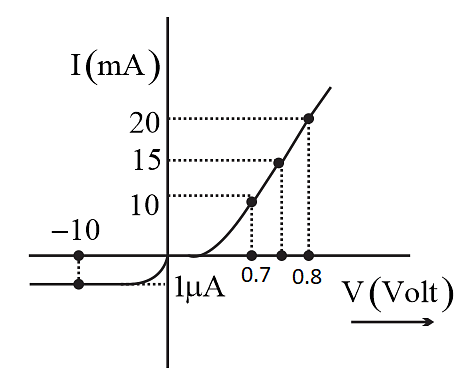Question
Physics Question on applications of diode
The V-I characteristic of a diode is shown in the figure. The ratio of forward to reverse bias resistance is:
10
10-6
106
100
10-6
Solution
The forward I-V characteristic is when the diode is forward-biased, and the anodewith respect to the cathode is positive. On the other hand, the reverse I-V characteristics are observed when the cathode is positive with respect to the anode.
Formula Used:
Forward bias resistance Rf is given as - Rf=ΔIfΔVf
- where, ΔVf is the difference between forward bias voltages,
- ΔIf is the difference between currents.
Reverse bias resistance Rr is given as - Rr=ΔIrΔVr
- where, ΔVr is the difference between reverse bias voltages,
- ΔIr is the difference between currents.
Complete step-by-step answer:
The forward resistance offered by a diode in forward bias is very small. On the other hand, a diode offers very high reverse resistancewhen it is in reverse bias.
The formula for forward bias resistance Rf is given as Rf=ΔIfΔVf→................(1)
- where, ΔVf denotes the difference between forward bias voltages.
- ΔIf is the difference between currents approximating particular voltages.
From the given diagram, the current ranges from 10 to 20 milli-Amperes. Therefore, ΔIf=20−10
⇒ΔIf=10mA
⇒ΔIf=10×10−3A
and the voltage ranges from 0.7 to 0.8 V.
⇒ΔVf=0.8−0.7
⇒ΔVf=0.1V
Substituting the values in equation (1)
Rf=ΔIfΔVf
⇒Rf=10×10−3Ω0.1
⇒Rf=10Ω
The formula for reverse bias resistance Rr is given as:
Rr=ΔIrΔVr→................(2)
- where, ΔVr is the difference between reverse bias voltages
- ΔIr is the difference between currents corresponding to particular voltages.
Also according to the diagram, the reverse bias current will be
Rr=ΔIrΔVr
⇒Rr=10−610Ω
⇒Rr=107Ω
Then, the ratio of forward bias to reverse bias resistance can be written as:
Ratio=RrRf
⇒Ratio=10710Ω
∴Ratio=10−6Ω
Hence, option B is the correct answer.
Note: The formula for reverse bias resistance and forward bias resistance can be written with the help of Ohm’s Law. Ohm’s law is given by V = IR.
- where V is the voltage,
- I is the current
- R is the resistance.
Thus, resistance can be written as R = VI
Independently in terms of forward and reverse bias resistance, this equation becomes Rr=ΔIrΔVr
And Rr=ΔIrΔVr respectively.
